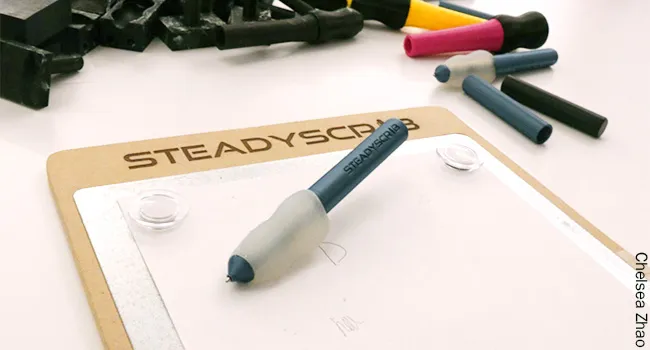May 12, 2023 — Student entrepreneurs at Northwestern University outside Chicago invented a pen set that allows Parkinson’s disease patients to write again despite the tremors of the disease.
SteadyScrib, a pen designed with these symptoms in mind, seeks to counteract the unsteady tremors of Parkinson’s with pens that have a magnetic core and a pliable grip. The specialized pen is intended to help with three symptoms of Parkinson’s: tremors, slowness of movement, and rigidity.
A thin, steel-coated board and four magnets lock the paper into place. The pen, filled with a weighted core and held with a pliable grip, steadies the shaky movement that often impairs a Parkinson’s patient’s ability to write. The magnetic force of the pen to the clipboard stabilizes the tip of the pen, and the user can then write legibly with ease.
Isabelle Mokotoff, a junior majoring in journalism at Northwestern and co-founder of SteadyScrib, said their goal was to create a pen with intuitive design for Parkinson’s patients.
“I think our core values are that we wanted it to be specialized, meaning there is currently no writing solution on the market that’s specifically designed for people with Parkinson’s,” Mokotoff said. “We wanted to specially cater to that market because there is such a huge quality of life gap.”
Mokotoff came up with the idea when her grandfather, a lifelong writer, lost his ability to write due to Parkinson’s. Mokotoff shared her frustration with her sorority sister and Northwestern University junior Alexis Chan, a biomedical engineering major who collaborated to bring Mokotoff’s vision to life.
Mokotoff and Chan did more than 100 interviews with Parkinson’s patients, their family members, and occupational therapists to validate the need of a writing tool for Parkinson’s patients.
They tested multiple materials before settling on neodymium magnets as the key in creating a pen that steadies the tremor of people with the disease. Using the 3D printer at the Garage, Northwestern’s innovation lab, the students created the first prototypes last summer. They then set out to test the pen sets in a local Parkinson’s support group, Evanston Movers and Shakers.
The SteadyScrib pen set, created through 3D printers at the Garage, an interdisciplinary entrepreneurship space for Northwestern University students.
Cissy Lacks, a member of Movers and Shakers, tried out the SteadyScrib pen set and said it functioned better than other pens she had tried before. Lacks has had Parkinson’s for 3 years with mild symptoms. As a theater review contributor for the local newspaper, the Evanston Round Table, Lacks hopes to use the invention for taking notes during interviews.
She said that the pen set also addresses needs such as writing cards for friends and family, filling out forms and questionnaires for the doctor’s office, or writing checks.
“Instead of my hand stopping or getting tired, it just moved really easily,” Lacks said. “So my hand did not put a lot of effort into making [the pen] work. And the size of the letters stay the same, which is really important.”
Lacks said that in living with Parkinson’s disease, intention is important to perform an action. However, this only temporarily applies to writing, as the letters tend to get smaller due to dysgraphia, a neurological condition that impairs handwriting in various ways. She said SteadyScrib seemed to solve this problem.
“I can really think about the writing and it looks OK, but two lines later it might get a lot smaller. But that wasn’t the case with this system. It pretty much stayed the same,” she said.
The SteadyScrib pen set includes a pen with a neodymium magnet core and a metallic metal sheet underneath the paper.
Rebecca Gilbert, MD, PhD, chief scientific officer at the American Parkinson Disease Association, said she has seen utensils and pens for Parkinson’s patients but no device that uses magnets to stabilize the tremors.
Gilbert said Parkinson’s disease impacts the motor planning skill of the patients, mostly when the patient is at rest. Dystonia, or involuntary muscle contractions, and dyskinesia, or muscle spasms, are some symptoms that can disrupt the writing process.
According to Mokotoff, more than 1,000 people have added their names to a waiting list for a SteadyScrib set. The demand is more than the manufacturing capacity at the innovation space on campus, so SteadyScrib is now looking for a partner to help scale production to meet consumer needs. SteadyScrib received five grants totaling $43,680, and Mokotoff said SteadyScrib is working with several potential partners with an interest in manufacturing the product.
Chan said SteadyScrib plans to add an additional feature to retract the pen nib to prevent the ink from drying. SteadyScrib also works to tailor the pen to the Parkinson’s symptoms of its users.
For instance, patients fall into a spectrum of Parkinson’s symptoms resulting from tremors of other neurological challenges. Mokotoff said her team is working to adjust the pen according to these findings for a more inclusive and responsive product.
“We designed our pen [based] on the most common rated inhibitive symptoms,” Mokotoff said. “But you know, the concern isn’t one size fits all.”
Parkinson’s disease is a neurological disorder that results in shakiness in movements or difficulty in walking and talking in severe cases. As the symptoms progress, fine-motor skills such as writing become increasingly difficult to accomplish. According to the National Institute of Neurological Disorders and Stroke, Parkinson’s is the second most common neurodegenerative after Alzheimer’s in the United States.
SteadyScrib is patented, and the co-founders send monthly updates about development through a newsletter.

